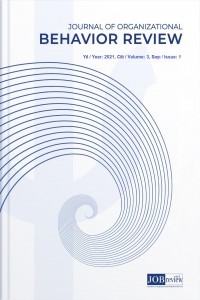Sessiz İstifa: Sonun Başlangıcı mı Yeniden Diriliş mi?
“Sessiz İstifa” son dönemde örgütsel davranış disiplininde popülaritesi artan en önemli kavramlar arasında yerini almaktadır. Sessiz istifa kavramı işten ayrılma anlamına gelmeyip, iş yerinde daha az sorumluluk alma ve işi aksatmadan asgari düzeyde performans gösterme süreci olarak tanımlanmaktadır. Yani çalışanların işlerine olan bağlılıklarını göstermek için kişisel zamanlarını, sağlıklarını ve mutluluklarını feda etmelerinin beklendiği “koşuşturmaca kültürüne” karşı sessiz bir manifesto olarak nitelendirilebilir. Bu çalışmanın amacı, sessiz istifa kavramının ortaya çıkış hikâyesini temellendirmek, olası etkileri bakımından çalışanlar ve örgütler açısından sebep olacağı sonuçları ele almaktır. Bununla birlikte pandemi sonrası iş hayatında yaşanan paradigma değişimi üzerine derinlemesine düşünmeyi teşvik etmek ve ileride yaşanabilecek bu türdeki örgütsel çalkantıların önlenebilmesi için öneriler sunmaktır. Kavram, sosyal medya üzerinde parlamış ve çoğunlukla dijital medyada irdelenmiştir. Akademik düzlemde ise çalışanların sessiz istifa süreci ile ilgili bilişsel, duyuşsal ya da davranışsal boyutta ampirik bir çalışmaya rastlanmamıştır. Dolayısıyla bu araştırma, kavrama ilişkin sınırlı sayıdaki kaynakların incelendiği bütüncül bir değerlendirme yapılmaya çalışılan betimsel bir çalışmadır. Sessiz istifa sürecinin kuramsal temellerinin açıklandığı çalışmaların artması ve deneysel çalışmalarla desteklenmesi ile akademik olarak kabul görmesi kolaylaşacaktır. Yapılan bu çalışmanın da ileride yürütülecek olan araştırmalar için kaynak niteliği taşıyacağı ve örgütlerin üst yönetimlerine karşı, çalışanların sessiz çığlıklarının duyulmasını sağlayacak bir araç olabileceği düşünülmektedir.
Anahtar Kelimeler:
Sessiz İstifa, Örgütsel Sessizlik, Tükenmişlik, Büyük İstifa, Karanlık Liderlik
Quiet Quitting: Is Beginning of the End or Reborn?
The concept of quiet quitting does not mean leaving the job, but is defined as the process of taking less responsibility in the workplace and performing at the minimum level without interrupting the work. In other words, it can be described as a silent manifesto against the “hustle culture” where employees are expected to sacrifice their personal time, health and happiness to demonstrate their commitment to their work. The aim of this study is to ground the story of the emergence of the concept of quiet quitting, and to discuss its possible effects in terms of employees and organizations. In addition, it is to encourage reflection on the paradigm shift in business life after the pandemic and to offer suggestions for preventing different organizational crises that may occur in the future. At the academic level, the quiet quitting status of the employees has not been the subject of an empirical study in cognitive, affective or behavioral dimensions. Therefore, this study is a descriptive study that tries to make a holistic evaluation in which the limited number of resources related to the concept are examined. It is thought that this study will be a source for future research and can be a tool that will enable the silent cries of the employees to be heard against the senior management of the organizations.
Keywords:
Quiet Quitting, Organizational Silence, Burnout, Great Resignation, Dark Leadership,
___
- Afrahi, B., Blenkinsopp, J., de Arroyabe, J. C. F. ve Karim, M. S. (2021). Work disengagement: A review of the literature. Human Resource Management Review, 32, 100822. doi:10.1016/j.hrmr.2021.100822
- Aydın, E. ve Azizoğlu, Ö. A. (2022, Ekim). New term for an existing concept: Quiet quitting-a selfdetermination perspective [Tam]. 5. Uluslararası Sosyal Bilimlerde Kritik Tartışmalar Kongresinde sunulan bildiri, Demokrasi Üniversitesi, İzmir. Erişim adresi: http://iccdss.idu.edu.tr/?page_id=727
- Başar, U., Sığrı, Ü. ve Basım, N. (2016). İş yerinde karanlık liderlik. İş ve İnsan Dergisi, 3(2), 65-76. doi:10.18394/iid.61037
- Baumann, O. ve Sander, E. J. (2021). Psychological impacts of remote working under social distancing restrictions. D. Wheatley, I. Hardill , & S. Buglass (Ed.), Handbook of Research on Remote Work and Worker Well-Being in the Post-COVID-19 Era (s. 1-17) içinde. Avustralya: IGI Global. doi:10.4018/978-1-7998-6754-8.ch001
- Conger, J. A. (1990). The dark side of leadership. Organizational Dynamics, 19(2), 44-55. doi:10.1016/0090- 2616(90)90070-6
- Çakan, S. (2022). Karanlık Liderlik. L. Sürücü (Ed.), Liderliğin Karanlık Yüzü içinde (s. 17-31). Ankara: Orion Kitabevi.
- De Smet, A., Dowling, B., Hancock, B. ve Schaninger, B. (2022). The Great Attrition is making hiring harder. Are you searching the right talent pools? McKinsey Quarterly. Erişim adresi: https://www.mckinsey.com/capabilities/people-and-organizational-performance/our-insights/thegreat-attrition-is-making-hiring-harder-are-you-searching-the-right-talent-pools
- Dean Jr, J. W., Brandes, P. ve Dharwadkar, R. (1998). Organizational cynicism. Academy of Management Review, 23(2), 341-352. doi:10.5465/amr.1998.533230
- Diener, E. ve Lucas, R. E. (2000). Explaining differences in societal levels of happiness: Relative standards, need fulfillment, culture and evaluation theory. Journal of Happiness Studies: An Interdisciplinary Forum on Subjective Well-Being, 1(1), 41-78. doi:10.1023/A:1010076127199
- Formica, S. ve Sfodera, F. (2022). The great resignation and quiet quitting paradigm shifts: An overview of current situation and future research directions. Journal of Hospitality Marketing &Management, 31(8), 899-907. doi:10.1080/19368623.2022.2136601
- Fuller, J. ve Kerr, W. (2022). The great resignation didn’t start with the pandemic. Harvard Business Review. Erişim adresi: https://hbr.org/2022/03/the-great-resignation-didnt-startwith-the-pandemic Teschner, D. P. (2022). The quiet-quitting reality. New Hampshire Business Review, 44(20), 9. Available from ProQuest. Erişim adresi: https://www.proquest.com/docview/2725349629/citation/7D46BF9234F845A3PQ/1?accountid=718 1
- Gallup (2022). Is quiet quitting real? Erişim adresi: https://www.gallup.com/workplace/398306/quiet-quittingreal.aspx
- Graham, J. W. (1983). Principled organizational dissent (Doktora Tezi). ProQuest Dissertations and Theses veri tabanından erişildi. (UMI No: 8403425.).
- Ipsen, C., van Veldhoven, M., Kirchner, K. ve Hansen, J. P. (2021). Six key advantages and disadvantages of working from home in Europe during COVID-19. International Journal of Environmental Research and Public Health, 18(4), 1826. doi:10.3390/ijerph18041826
- İrfan, O. (2022). Çalışan deneyimi. İstanbul: Ceres Yayınları.
- Jo, Y. ve Lee, D. (2022). Activated at home but deactivated at work: How daily mobile work leads to next‐day psychological withdrawal behavior. Journal of Organizational Behavior, 43(1), 1-16. doi:10.1002/job.2563
- Kahn, W. A. (1990). Psychological conditions of personal engagement and disengagement at work. Academy of Management Journal, 33(4), 692-724. doi:10.2307/256287
- Kassing, J. W. (1998). Development and validation of the organizational dissent scale. Management Communication Quarterly, 12(2), 183-229. doi:10.1177/089331899812200
- ISSN: 2687-2609
- Yayın Aralığı: Yılda 2 Sayı
- Başlangıç: 2019
- Yayıncı: Sema POLATCI
